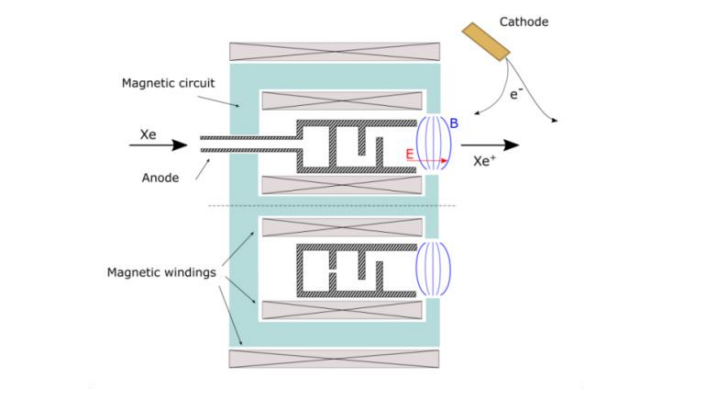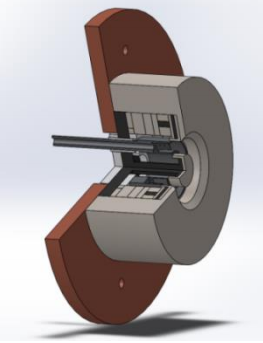In the recently published ‘Improvements in miniaturized Hall Thrusters by use of high-temperature SmCo magnets and additive manufacturing techniques,’ authors A. Olano, J. Ren, G. Zhang, H. Tang, T. Zhang, and J. Li explore AM processes, miniaturization, and magnet technology further.
In this study, the research team strives to solve challenges associated with aerospace and satellite applications, especially as engineers trend toward developing both micro- and mini-satellites for low Earth orbit (LEO) missions, to include:
- Journeys to Earth observation platforms
- Large constellations of satellites to provide internet coverage
- Drag compensation
- Debris removal
- De-orbiting at the end of a mission
As the researchers seek better ways to miniaturize major components like hall thruster engines, it is critical to understand the challenges involved—mainly involving issues that revolve around power. New materials and techniques have the potential to refine such electric propulsion systems further, but requirements such as magnetic field topography and uniform propellant distribution must be considered.
With 3D printing, the research team expects that they may be able to solve multiple challenges, along with being able to create more complex geometries—and some that are completely unattainable with conventional methods; however, the study is centered around how magnetic materials will allow Hall thrusters to adapt to lower power sources—around 100 watts.
“Hall thruster engines are propulsion systems where the thrust is achieved by electrostatically accelerating ions out of the thruster,” explain the researchers. “An axial electric field is created between an anode and a cathode, which for Hall Thruster is usually a hollow cathode and is the source of the electrons. In order to avoid the electrons streaming directly to the anode, a radial magnetic field is established perpendicular to the electric field creating an ExB drift motion in the electrons (Hall current) perpendicular to the electric and magnetic fields.”
3D printing and additive manufacturing processes have been used in previous manufacturing of prototypes, functional components, and for electric propulsion—manufacturing the channel and parts of the distributor for the Hall thruster, using both PEI and ABS. In previous work, however, there were still challenges to overcome regarding temperature, and the researchers saw AM with metal to overcome obstacles. In particular, the research team was encouraged using metal grids fabricated via SLM rather than conventional methods. Production time is decreased in some cases up to 400 hours, as well as anywhere from hundreds to thousands of dollars.
“By using SLM for the anode, we can just not reduce the cost and time span for the manufacturing but we can design a more complex geometry that provide better azimuthal uniformity in the propellant flow at the exit of the anode,” stated the researchers. “In Hall thrusters, the anode is not only the positive bias for the electrostatic field but it has the additional function of distributing the propellant flow all around the discharge chamber.”
A manifold transferring flow from the inlet to the discharge channel is necessary, but with the use of traditional techniques, there are still limitations due to miniaturization issues. The researchers discovered that the diameter could not be smaller than 0.5mm for the manifold orifices.
“Using SLM for the manufacture of the anode, we can introduce modifications in the geometry with the aim of slowing down the flow and allowing for homogeneous flow diffusion along the channel. Two different geometries have been chosen to illustrate the benefits of using SLM. In design A, it was included just a simple set of baffles that redirect the flow after the propellant is injected through the orifices. In design B, a more complex geometry is used to redirect the flow with similar purposes,” stated the researchers.
“Porosity can be reduced by post-processing methods as finish machining or it may induce fatigue failures of the material. In any case, as the anode is not a structural component of the thruster, it is not a major concern the surface quality of the anode after 3D printing.”

Magnetic field topography (left), magnetic field at halfway of the discharge channel along the radial coordinate (center) and magnetic field for different radial coordinates along the axis coordinate(right).
3D printing is associated with a wide range of magnetics today, from composite materials to organic materials, those mixed with other materials, and more.
What do you think of this news? Let us know your thoughts! Join the discussion of this and other 3D printing topics at 3DPrintBoard.com.
[Source / Images: ‘Improvements in miniaturized Hall Thrusters by use of high-temperature SmCo magnets and additive manufacturing techniques’]Subscribe to Our Email Newsletter
Stay up-to-date on all the latest news from the 3D printing industry and receive information and offers from third party vendors.
You May Also Like
Gorilla Sports GE’s First 3D Printed Titanium Cast
How do you help a gorilla with a broken arm? Sounds like the start of a bad joke a zookeeper might tell, but it’s an actual dilemma recently faced by...
Nylon 3D Printed Parts Made More Functional with Coatings & Colors
Parts 3D printed from polyamide (PA, Nylon) 12 using powder bed fusion (PBF) are a mainstay in the additive manufacturing (AM) industry. While post-finishing processes have improved the porosity of...
$25M to Back Sintavia’s Largest Expansion of Metal 3D Printing Capacity Since 2019
Sintavia, the digital manufacturing company specializing in mission-critical parts for strategic sectors, announced a $25 million investment to increase its production capacity, the largest expansion to its operations since 2019....
Velo3D Initiates Public Offering in a Bid to Strengthen Financial Foundations and Drive Future Growth
Velo3D (NYSE: VLD) has been among a number of publicly traded 3D printing firms that have attempted to weather the current macroeconomic climate. After posting a challenging financial report for 2023,...


































